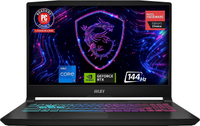This excellent $1,030 RTX 4070 gaming laptop is what happens when AMD and Nvidia play nice and will arrive just after Christmas
Even the 16:10 screen gets to join in with the fun.

Acer Nitro 16 | RTX 4070 | AMD Ryzen 7 7735HS | 16-inch | 165Hz | 1600p | 16GB DDR5 | 512TB SSD | $1,299.99 $1,029.99 at Walmart (save $270)
This is one of the cheapest RTX 4070 deals around at the moment and there's a lot to like here. The Ryzen CPU has a full eight cores, 16 threads, and that GPU is a high power version, with a 140W limit. The screen is fast and boasts a nice 16:10 ratio. However, the resolution is a bit high for the RTX 4070, so you might need to use upscaling more often than you'd like, and the amount of storage is pretty mean. But if you want to save as much as you can but still get a decent gaming laptop, this one's hard to beat.
Price check: Amazon $1,219.94
Lots of gaming laptops use 16:9 1080p screens because they're cheap to buy and usually boast a high refresh rate. However, they're not great for doing office work or any productivity tasks, unless the panel is really big. But when they are, the low resolution just looks yuck.
Enter stage left this Acer Nitro 16 gaming laptop. Here you're getting a 16-inch IPS panel that has a resolution of 2560 x 1600, resulting in a 16:10 screen ratio. That means you get a little more vertical height to work with and once you've used such a panel, it's hard to go back to something smaller. This one's fast, too, with a refresh rate of 165Hz so it'll be very easy on the eyes.
The rest of the hardware is just as good, although there are a couple of things that spoil the party a touch. Kicking things off is the CPU: a Ryzen 7 7735HS. It has eight full cores, 16 threads, and a boost clock of 4.75GHz. It doesn't have as much cache as the desktop Ryzen CPUs but it's still a great laptop processor.
It's paired with a GeForce RTX 4070 GPU and not one of the low-end versions. This one has a power limit of up to 140W and we tested one of these in our Razer Blade 14 review. It's better suited to 1080p gaming but it still handles 1600p well enough, and you'll always have DLSS Super Resolution and Frame Generation to turn to, if you need higher frame rates.
We've had a look at the Acer specs sheet for the Nitro 16 and I'm a little worried that it doesn't explicitly state that the 16GB of DDR5 memory installed in the machine is in a dual-channel configuration. It seems likely that it is, given that we've seen specs for entry-level and higher-end versions both using dual-channel DDR5, but if it turns out to be just a single 16GB stick of memory that Ryzen is going to be an unhappy little chip.
The worst part of this laptop is the amount of storage. Sure, it's an NVMe PCIe 4.0 drive so it should be plenty fast enough but 512GB these days just isn't enough. You can always replace it with a larger SSD and they're still very cheap at the moment, but you will have the hassle of reinstalling the operating system. Though there is a second M.2 slot inside if you want to add some easy additional storage to the system.
There are two 10Gbps USB Type-C ports so you also use an external SSD for storing large files and documents, leaving the internal drive just for games. You just won't be able to have many of them installed, if you like the latest AAA games.
But that's it for the downsides. Everything else is really good and if you're looking for a gaming laptop that you can do school work or light content creation on, you're going to be hard pushed to find a better deal than this one. You know this just might make a great Christmas gift for someone!
Keep up to date with the most important stories and the best deals, as picked by the PC Gamer team.

Nick, gaming, and computers all first met in 1981, with the love affair starting on a Sinclair ZX81 in kit form and a book on ZX Basic. He ended up becoming a physics and IT teacher, but by the late 1990s decided it was time to cut his teeth writing for a long defunct UK tech site. He went on to do the same at Madonion, helping to write the help files for 3DMark and PCMark. After a short stint working at Beyond3D.com, Nick joined Futuremark (MadOnion rebranded) full-time, as editor-in-chief for its gaming and hardware section, YouGamers. After the site shutdown, he became an engineering and computing lecturer for many years, but missed the writing bug. Cue four years at TechSpot.com and over 100 long articles on anything and everything. He freely admits to being far too obsessed with GPUs and open world grindy RPGs, but who isn't these days?


